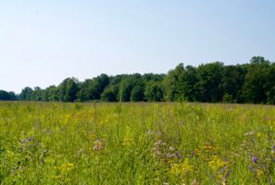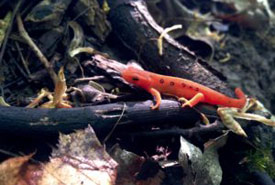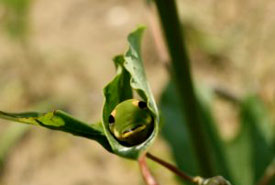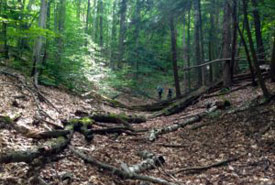From prairie to forest: My journey to a new natural area

Tall grass prairie (Photo by Jenna Siu/NCC)
I spent many of my formative years as a field biologist in the Carolinian region of Ontario, which includes Norfolk and the surrounding counties. The fragmented landscape is largely agricultural with bits of restored tallgrass prairie and scattered tracts of Carolinian forest. It’s one of the most naturally diverse places in Canada.
I spent time getting to know the Carolinian region while collecting data about butterflies for my master’s research, as well as tracking American badgers and finding snakes and turtles for work. In many ways it was comfortable place to be; I was familiar with the area, the community and the biodiversity. But change can be a good thing, too.
This past spring I moved to work for the Nature Conservancy of Canada (NCC) in the Happy Valley Forest, a largely upland deciduous forest. It’s located in King Township, just north of the Greater Toronto Area. At 1,560 acres (631 hectares), it is one of the largest remaining tracts of forest along the Oak Ridges Moraine. To date, NCC has helped protect nearly 700 acres (283 hectares) of it!
The Happy Valley Forest may only be about a two-hour drive north from Norfolk County, but the differences are distinct. I was sad to leave that familiarity behind, but I was also excited to start a new adventure. Of course, anything new comes with new challenges.

Red eft, the juvenile stage of the eastern newt, common in Happy Valley Forest (Photo by Jenna Siu/NCC)
My past home in Norfolk County was located in a much more rural area. The landscape is dominated by agricultural fields intersected by country roads and dotted with roadside vegetable stands, which I miss very much. The atmosphere in Norfolk is relaxed.
In contrast, Happy Valley Forest is an island surrounded by the growing pressure of urban development. I live outside the big city, but the hustle and bustle of urban sprawl is ever present. Fancy cars weave in and out of lanes without signalling and drivers honk uncontrollably. My well-worn Matrix, which has seen a few dirt roads, seems out of place.
The terrain is another noticeable difference. There can be some steep ravines in the Carolinian forests, but overall the landscape is flat and easy walking. Happy Valley Forest, on the other hand, sits on the Oak Ridges Moraine, a prominent geological feature in the Ontario landscape.
In the last ice age, about 13,000 years ago as glaciers began to retreat, they deposited sediment as they moved along creating deep valleys and hills — a moraine. Historically, the area was logged. Due to the difficult conditions of the logging camps and the hilly terrain, the workers jokingly named the area Happy Valley Forest, or more accurately, Pinchgut. Hiking here took some getting used to. Nonetheless, it makes for good exercise and a beautiful landscape to work in.
One of the more difficult things to overcome was the difference in species. In my mind, the appeal of the Carolinian region is its vast diversity of plants and animals. It’s situated at the northern edge of the range for many species that are uncommon or don’t occur in other parts of Ontario.

Spicebush caterpillar (Photo by Jenna Siu/NCC)
I knew when I moved I would no longer see the species that I got to know well in Carolinian Canada: spicebush swallowtails (or spicebush the understory shrub), tulip trees, American badgers, foxsnakes, and many others. The Happy Valley Forest may not have the diversity that the north shore of Lake Erie does, but it has its own appeal.
For me, one of the big draws to Happy Valley has become the expansive older growth forest. Sugar maple and American beech are dominant species, with some red oak and towering white pine, and the long-lived eastern hemlock in wetter areas. It’s hard to believe that once upon a time before European settlers, much of the southern Ontario landscape would have been covered in forests such as this one. Thanks to the landowners today, who have been stewards of the land, the Happy Valley Forest has regenerated in the last few hundred years and is expected to reach “old-growth” status in the next 50 years.
I love seeing the forest floor covered in maple seedlings and spring ephemerals and finding trees that are hundreds of years old. I love spotting tree cavities and wondering if it’s housing an owl, flying squirrel or bats. The rotting logs make perfect habitat for salamanders, insects and weird and wonderful fungi. These are some of my favourite characteristics of Happy Valley, an old growth forest in the making.

Typical scenery in Happy Valley Forest (Photo by NCC)
Having such a large and well-connected landscape means that it’s more resistant to natural disturbances and disease. Animals that have large habitat area requirements can thrive. There is also a large interior forest for those species that depend on that type of habitat. Ecologists say that the deep woods begin 100 metres in from the forest edge. Therefore large forests that have sizeable interior forest, like Happy Valley, are critical places to protect.
Working in each new natural area has its charms. I’m fortunate enough to get to know these places a little more intimately. Although moving to a new area can often feel like starting from the bottom again, I’ve learned that I bring my previous knowledge to each new experience. As scary as change can be, it’s how we learn and grow. In a field as complex as ecology, maybe every year should be called a “formative year.”
This post originally appeared on Jenna Siu's blog and is adapted and reposted with permission on Land Lines.


